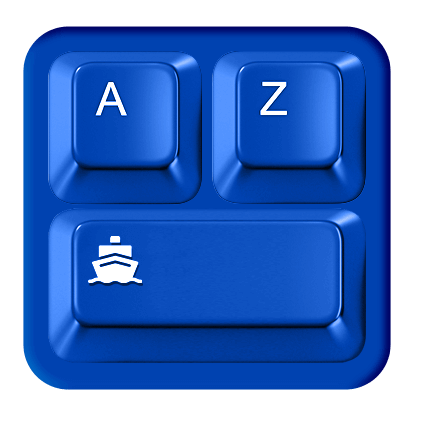| Term | Definition |
| Cabotage | Cabotage is a maritime law term that refers to the right of a country to regulate the transportation of goods and passengers between two points within its borders. The term is typically used in the context of shipping and aviation. |
| Car Transport | Car transport is transporting a vehicle from one location to another using various methods, including sea, air, and land. The most common type of car transport is by road on an especially truck. |
| Cargo | Cargo refers to goods or products being transported from one place to another by water, air, or land. Cargo transport is mainly for commercial purposes for which the carrier issues an air waybill, bill of lading, or another receipt. |
| Cargo Insurance | Cargo insurance is insurance that covers goods in transit. It is a type of insurance that covers the loss of goods against possible losses and protects shipments from physical damage or theft that may occur during air, sea, or land transportation. |
| Cargo List | A cargo list is a list of the items being transported on a ship, plane, or other vehicle and shows the detailed number of goods to be unloaded at the port. |
| Cargo Retention Clauses | Cargo retention clauses are legal instruments that give charterers the right to deduct freight charges if their cargo is not in the same quantity described in the bill of lading. |
| Cargo Tracking Note | A cargo tracking note is a document used by freight forwarders and logistics companies to track cargo shipments. The tracking number is used to identify the shipment and its current location and includes information about the sender, recipient, and other details about the shipment. |
| Carriage and Insurance Paid to (CIP) | Carriage and insurance paid to (CIP) is a term used in international trade that indicates who is responsible for paying the shipping and insurance costs associated with delivering goods to the buyer. The term is typically used when the buyer and seller are located in different countries. |
| Carriage Chargeable Weight | The carriage chargeable weight of a shipment is the total weight of the shipment, including the weight of the packaging. The transport costs of an order are calculated based on this information. When determining the freight rate, the forwarder calculates the theoretically optimal ratio of weight and volume (L x W x H) to utilize a means of transport fully. The weight subject to freight charges corresponds either to the weighing weight or the volume weight of a shipment. The higher is always taken as the basis for calculation. |
| Carriage Paid to (CPT) | Carriage paid to (CPT) is a commercial term used to indicate that the seller delivers the goods being sold to the carrier or another person nominated by the buyer at the seller’s own expense and risk. |
| Carrier | A carrier is a company that offers shipping services for goods or people. |
| Carrier Assets | Carrier assets are the physical resources that a carrier uses to provide services. These assets may include distribution network infrastructure, vehicles, special transport services, own gear, warehouses, and facilities. |
| Cartage | Cartage is the cost of shipping goods from one location to another by land. |
| Cartage Agent | A cartage agent is someone who arranges for the transportation of goods on behalf of their client. |
| Cash Against Documents (CAD) | Cash against documents is a payment method or tool used in international transactions between a seller and buyer, where the importer pays for the ordered goods before they are received. |
| Central Warehouse | A central warehouse is a storage facility within a warehouse management system that is part of a supply chain structure. Generally, the central warehouse is managed by retailers or a logistics service provider. |
| CEP | The acronym CEP stands for “Circular Error Probable.” CEP refers to postal and logistics companies that primarily transport consignments with comparatively low weight and volumes, such as letters, small packages, documents, or small items. |
| Certificate of Compliance | A certificate of compliance is a document that certifies that a product or system meets all the requirements of a given standards organization. |
| Certificate of Conformance | A certificate of conformance is a document that certifies that a product or service meets all the requirements of the relevant specification. It is usually issued by the manufacturer or supplier of the product or service. |
| Certificate of Conformity (CoC) | A certificate of conformity is a document that certifies that a product, system, or service meets the requirements of the regulation, specification, or standard. CoC is also called the Certificate of Compliance and the Certificate of Conformance. |
| Certificate of Origin | A certificate of origin is a document used in international trade that certifies the country of origin of the goods being shipped. The certificate of origin is typically used for goods shipped from one country to another and is subject to tariffs or other trade restrictions. |
| Channel Rack | A channel rack is a type of rack storage system that allows storing several units in a square or channel. This system comprises several flow lanes or slide-in channels arranged in a honeycomb pattern on top of each other and next to each other. The individual channel racks are served by a forklift truck. |
| Chaotic Storage | Chaotic storage is a type of storage where items are stored in a random or unorganized way. This can make it challenging to find items when needed and can lead to items being lost but leads to faster processing. |
| Charterer | A charterer is a person or company renting vehicles to transport goods from one location to another. The charterer may be the owner of the goods being transported or the owner’s representative. |
| Clean Bill of Lading | A clean bill of lading is a deed provided by the carrier to certify that the shipment was received undamaged and in good condition. |
| Clearance | Clearance is a statement indicating a shipment can enter the country freely when all legal criteria have been satisfied. |
| Closing | Closing or Estimated Time of Completion (ETC) is the completion time estimated for the tasks relating to loading or unloading goods. |
| CMR | The CMR is an agreement that regulates road freight transport. The agreement was concluded in 1956 under the auspices of the UN, and all European states, some states in Central Asia and the Middle East, and two African countries have since joined the agreement. The CMR waybill is a document that must be used in order for the transport of goods to be regulated by the agreement. The waybill must include the date and place of completion, the name and address of the transport company and the consignee, a description of the goods and the packaging method used, the weight of the goods, and the charges related to the goods, and the information regarding dangerous goods. |
| CMR Waybill | A CMR waybill is carried out based on the CMR “Convention relative au contract de transport international de merchandises par route.” A CMR waybill is a document used for international transport. The driver and the shipper use document to save the shipment details, including the description of the goods, the origin and destination of the shipment, and the route is taken. |
| Cockpit | A cockpit, also known as a driver’s cab, is a small enclosure or cabin in front of a vehicle where the pilot or driver sits and safely drives the plane or vehicle. |
| Collector and Collection Request | A collector is a person who comes along as a client to collect the shipment directly from the shipper based on a collection request. |
| Code of Conduct | A code of conduct is a set of specific guidelines and rules outlining the expected behavior of members of an organization or a particular group, and it outlines the responsibilities and practices of the individual employee. These rules are typically designed to promote the organization’s core values and protect its members’ rights. |
| Coil Well | A coil well is a type of storage tank used to store liquids or gases in a tightly wound coil. These tanks are often used to store volatile or dangerous materials, as they can be securely sealed to prevent leaks. |
| Combined Transportation | Combined transportation is the shipment of goods using two or more modes of transportation. This type of transportation is often used when goods need to be shipped over long distances, as it can be more efficient and cost-effective than a single mode of transportation. |
| Commercial Invoice | A commercial invoice is a contract and proof of sales between two parties in an international transaction that details the number of goods sold, the prices, and their value. It is an essential document when exporting or importing goods. |
| commercial Vehicle | A commercial vehicle is a vehicle that is used for business purposes. There are various commercial vehicles, including delivery trucks, buses, and taxi cabs. Commercial vehicles are often heavier and larger than passenger vehicles and may be equipped with specialized features to help with business operations. |
| Commodity Code | A commodity code is a sequence of numbers used to identify products traded on the international market. The code tracks and records information about the product, such as its value, quantity, and destination. The code is also used to identify the product for customs purposes. |
| Community Transport | Community transport is any form of transport provided for the benefit of a community rather than for profit. This can include a wide range of transport services, from volunteer-run transport services to social enterprises providing low-cost transport. |
| Confirmation Order | A confirmation order is a document that serves as written confirmation of an agreement between a carrier and a shipper. The confirmation order proves that an order has been placed and accepted and serves as a binding agreement between the two parties. Without a confirmation order, it would be difficult to confirm the delivery of goods. |
| Consignee | A consignee is a party who is designated to receive goods that are being shipped. The consignee is typically the buyer of the goods but can also be the party who is responsible for paying freight charges. |
| Consignment Warehouse | A consignment warehouse is a storage facility where goods are stored on behalf of the consignee. The consignee is the party who owns the goods and is responsible for paying the storage fees. The consignment warehouse is responsible for safeguarding the goods and ensuring they are available for pick-up by the consignee when requested. |
| Consignor | A consignor is someone who sells items on behalf of another person or company. A consignor could be a seller or an exporter. This arrangement is often used when the consignor is more knowledgeable about the market for the item than the owner or when the owner does not have the time or resources to sell the item themselves. The consignor typically takes a percentage of the final sale price as their fee. |
| Consolidation | Consolidation is the process of combining several shipments into a single shipment to reduce shipping costs. This can be done by combining shipments from multiple suppliers into a single shipment or by consolidating multiple shipments from a single supplier into a single shipment. Shippers can reduce transportation costs, simplify logistics, and improve customer service by consolidating shipments. |
| Construction Transport | Construction transport refers to transporting construction materials, equipment, and workers to and from construction sites. Construction transport can be carried out by various means, including trucks, trains, buses, and helicopters. On a construction site, it is typically done when specific building supplies are urgently needed. |
| Container | A container is a metal box that is sealed, stiff, and reusable and is used to house goods that need to be transported by truck, ship, or rail. The container must be designed to carry items without requiring intermediary reloading, be built for repeated usage, and be simple to fill or empty. All containers must be built with fittings that can withstand any transit pressure that might be used during regular, continuous shipping. |
| Container Chassis | A container chassis is a device with wheels and other components that can be used to transport shipping containers. The chassis can be pulled by a truck or other vehicle and used to move containers from one location to another. |
| Container ID | The container ID is a unique identifier for a specific container. This is generally a 12-digit hexadecimal number assigned to a container by a carrier. |
| Container Load | A container load is a shipment that fills a container by weight or volume. Essentially, it refers to the number of goods that can be moved utilizing a typical shipping container. |
| Container Service Charge (CSC) | A Container Service Charge (CSC) is a fee charged by the container shipping company for the use of their containers. This fee covers the cost of maintenance and repairs, goods handling, unloading of the container, and crane service. |
| Container Transport | Container transport is a type of freight transport that involves the use of special containers to move goods by land, sea, or air. This type of transport is often used for international shipments, as it allows for goods to be securely packaged and transported without being damaged or lost. |
| Contraband | Contraband is any Cargo that is illegal to possess or transport and prohibited. |
| Contract Logistics | Contract logistics is a type of logistics service in which a company outsources its logistics operations to a third-party provider. The third-party provider oversees and manages all aspects of the company’s logistics operations, including transportation, warehousing, and customer service. |
| Contract Market | A contract market, defined as a registered exchange, is a trading venue that brings buyers and sellers together through an auction in which participants compete by offering prices and quantities they are willing to trade. Long-term contracts for complex logistics services are concluded there. |
| Contract of Affreightment (COA) | A contract of Affreightment (COA) is a convention between a ship-owner and a carrier for the transportation of goods by a specific mode of transportation over a specified route for a specified time. The contract may be for the transportation of a single shipment or a series of freight—the ship-owner consents to transport a particular volume of cargo for the carrier over a specific timeframe. |
| Contract Partner | A contract partner is a company or individual with whom you have a contractual relationship. This could be a supplier, customer, renter, borrower, lender, buyer, seller, or service provider. The contract partners can be located in different parts of the world and may have different legal systems. |
| Control Center | A control center is a tool to visualize current procedures, states, and situations of logistical processes. It is not a stand-alone system but rather an extension of an already existing system, like a warehouse management system. The control center is based on a data collector who takes information from the operative system’s database and stores it for further evaluation. It is configured by the user, who can define which key figures to display and evaluate. |
| Control Loop | A control loop is a process used to regulate a system automatically. It works by constantly comparing the system’s actual output to the desired result and then making adjustments to the system’s input to correct any discrepancies. |
| Conveying Aids | Conveying aids are devices that help to move goods from one place to another, making it easier to transport them and protecting goods during loading and unloading. They can include sacks, bags, cartons, storage boxes, conveyor belts, pulleys, and other similar devices. |
| Conveyor Technology | Conveyor technology is the process of moving goods from one location to another using a system of pulleys or rollers. |
| Conveyor System | A conveyor system is a device that moves items from one location to another. Conveyor systems are used in various industries, including mining, warehouses, production units, and many other places. |
| Corporate Logistics | Corporate logistics is a business field concerned with a company’s transportation, storage, and distribution of goods and materials. Corporate logistics’ goal is to organize efficiently, manage, carry out, and regulate the physical flow of commodities and the related flow of information along the company’s complete value chain. |
| Cost and Freight (CFR) | Cost and Freight (CFR) is a unique maritime shipping-only clause. CFR denotes that the seller arranges and finances the freight to a particular port and gives the purchaser the paperwork required to receive the goods. The products are considered fully loaded aboard a ship and approved for shipment, at which point the seller’s obligations are finished. Costs and hazards are transferred to the customer after the items are placed onto the vessel. |
| Cost, Insurance, and Freight (CIF) | Cost, insurance, and freight (CIF) is that the seller pays the cost of transporting the goods to the destination port and the cost of insuring the goods against possible damage in transit during transport. The buyer bornes the costs and risks of export from the port of destination to the final destination. |
| Country of Departure | The country of departure is the nation from which the goods or people are leaving. The country of origin is another name for the country of departure. |
| Country of Destination | The Country of Destination is the nation where the goods or people are moving to and where shipments will be offloaded. |
| Courier Service | A courier service is a person, postal, or logistics company that delivers messages or packages. |
| Crane | A crane is a piece of equipment that can lift and lower objects and move them horizontally. It is frequently furnished with a hoist rope, wire ropes or chains, and sheaves. Cranes are typically used in the transport sector to load and unload cargo, in the building sector to move materials, and in manufacturing and heavy industry to assemble and transport large pieces of machinery. |
| Credit Assessment | Credit assessment, or credit check, analyzes a borrower’s ability to repay a loan. This includes looking at the borrower’s credit history, employment history, and current financial situation. |
| Credit Rating | A credit rating refers to a person’s creditworthiness. It is used by lenders, including banks and credit card companies, to determine whether to extend credit and at what interest rate. Business creditworthiness is based on cash flow, profitability, and equity ratio variables. The higher the credit rating and the more favorable the debt financing, the better these factors are. However, for people, creditworthiness is determined by bank statements, data from a national credit agency, and evidence of income. |
| Cross-coupling | Cross-coupling is a sort of goods handling in which the sender or supplier pre-commits the items’ delivery. |
| Cross Docking | The Cross Docking process is a system where supplier’s products are distributed to customers with little to no storage time at the distribution terminal. This system is beneficial for warehouses processing perishable goods, as it helps to avoid delays. |
| Cubic Capacity | A cubic capacity measures the amount of space an object or container takes up and is usually expressed in cubic units such as cubic centimeters or cubic meters. |
| Cubic out | Cubic out is When a shipping container is fully loaded in terms of volume but not fully loaded in terms of weight. |
| Customized Software | Customized software is a program specifically designed for a specific customer or group of customers. The customer provides input on what they need the software to do, and the software is then created to meet those needs. |
| Customs | Customs is the area at a port, airport, or border where government agents oversee the arrival of products, people, and other loads. The customs authorities of a country are responsible for enforcing the customs laws of that country. Customs laws protect the country’s economy, residents, and visitors by regulating the import and export of goods. |
| Customs Agent | A customs agent is a person who is authorized by a country’s customs authority to enforce its customs laws. |
| Customs Clearance | Customs is the government organization responsible for regulating the flow of goods, people, and vehicles in and out of a country. The customs clearance process is completing all the necessary paperwork and requirements with Customs to bring goods into a country legally. |
| Customs Declaration | A customs declaration is a document that lists the details of goods that are being imported or exported when crossing an international border. The declaration includes information such as the type and quantity of goods, the value of the goods, and the country of origin. |
| Customs Duty | Customs duty is a levy paid on goods imported into a country. The amount of duty varies depending on the value and imported goods. Customs duty is typically calculated as a percentage of the imported goods’ value. |
| Customs Entry | A customs entry is a document filed with a country’s customs authority declaring goods imported or exported. The customs entry form declares the value, quantity, and type of goods being shipped and other important information such as the importer’s and exporter’s contact information. |
| Customs Invoice | A customs invoice is a form used to declare the value of goods imported or exported. Customs officials use the invoice to determine the amount of duty owed on the goods. |
All shipments in one place
We are with you until the end






